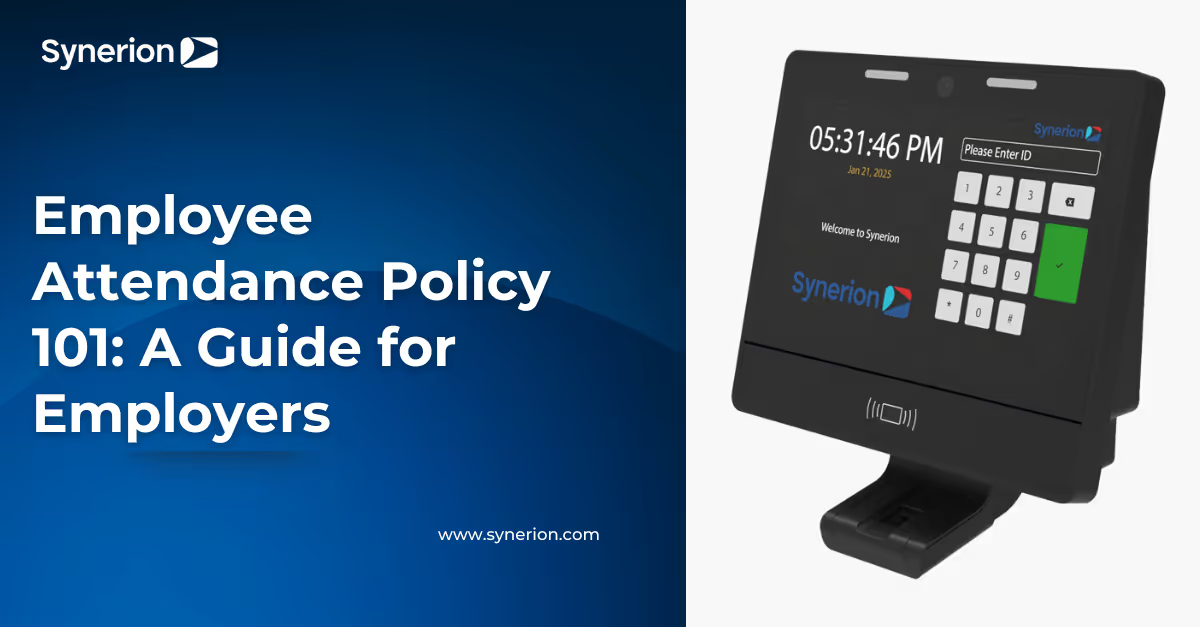
Employee Attendance Policy 101: A Guide for Employers

Employee attendance issues cost businesses billions annually, yet many companies operate without clear guidelines. A strong employee attendance policy prevents these losses while creating a fair workplace for everyone.
Your attendance policy does more than track who shows up. It sets the tone for your company culture, demonstrates what you value, and provides the structure employees need to succeed.
This post highlights the importance of creating and maintaining a clear employee attendance policy. We’ll discuss the benefits, how to create an attendance policy, and the tools and strategies to leverage along the way.
What Is An Employee Attendance Policy?

An employee attendance policy is a document that clearly states how employees should handle work attendance, absences, and time-off requests. It establishes when employees should be at work, how to request time off, and what happens if the rules aren't followed. A good policy creates fairness while protecting everyone's interests.
Your policy should specify working hours, legitimate reasons for employee absences, and how to report them. This helps ensure you have enough staff while holding everyone accountable.
- Operational efficiency: Prevents unexpected staffing gaps
- Legal protection: Documents rules and enforcement
- Fairness: Treats all departments consistently
- Communication: Makes expectations clear for everyone
The Importance of Managing Employee Attendance

Alt text: An employee looking at a tablet in an office.
Attendance directly affects your bottom line through productivity, morale, and customer satisfaction. When employees unexpectedly miss work (US full-time workers had a 3.2% absence rate in 2024), it disrupts your entire organization.
Unplanned absences create significant costs: replacement labor, administrative time, and productivity losses. When absences become frequent, reliable employees must shoulder extra work, often leading to burnout and resentment.
Impact on Productivity
Attendance issues affect your business in multiple ways:
- Direct costs: Overtime payments and temporary staffing expenses
- Quality control: Replacement workers often lack specific training
- Customer service: Understaffing leads to longer wait times
- Project delays: Key personnel absences postpone critical deadline
Staff attendance policy enforcement sends a clear message about your company's values and expectations. When attendance is monitored consistently, employees understand that reliability is valued and rewarded.
Common Attendance Challenges and Pitfalls
Last-Minute Call-Ins
Last-minute absences disrupt operations and force managers to find quick replacements. Combat this by requiring at least a 2-hour advance notice when possible and establishing an on-call system for critical roles.
Chronic Lateness
Persistent tardiness disrupts work and shows a lack of commitment. Even arriving five minutes late affects meetings, customer service, and production schedules.
Address both occasional and habitual lateness in your policy. Document each instance with exact times and explanations. After spotting a pattern (three late arrivals in a month), discuss the issue privately with the employee.
Key Elements To Include In An Employee Attendance Policy
There are a few key elements to include in an employee attendance policy for any organization. These include:
Clear Reporting Procedures
Your policy should specify exactly how employees should report absences or tardiness:
- Who to contact (direct supervisor, department manager, HR)
- Timeframe for notification (2 hours before shift, as soon as possible)
- Acceptable communication methods (phone call, text, email)
- Required information (reason for absence, expected return)
Different procedures should exist for planned versus unexpected absences. For planned time off, require submission through your time and attendance policy system with appropriate advance notice.
Defined Consequences
Establish a progressive discipline approach that allows employees to correct attendance issues:
- Verbal warning and documented conversation
- Written warning with a performance improvement plan
- Final written warning with possible suspension
- Termination consideration
Document each step in writing, including dates, specific incidents, and employee responses. Some companies implement an attendance point system policy where employees accumulate points for various infractions, with predetermined consequences at different thresholds.
Start With the Law
Many companies embark on creating an employee attendance policy without really understanding their local labor laws. Ensuring that everything is written to meet and exceed all applicable laws is vital. Federal laws such as FMLA and USERRA carry hefty fines if violated, so it's important that when crafting an employee attendance policy, you educate yourself on all applicable laws. When in doubt, contact those regulators to ensure your policy meets standards. If your employee attendance policy isn't rooted in law, it's not worth the paper it's written on
Identify Organizational Needs
Start by evaluating what your business needs:
- Industry type: Manufacturing needs differ from office settings. Healthcare support had the highest absence rate (4.3%) in 2024.
- Operating hours: 24/7 operations need different rules than standard business hours
- Required staffing: Minimum staff needed for safety and service
- Seasonal demands: Busy periods may need stricter attendance rules
Draft And Review Policy
Follow these steps to develop an effective policy:
- Research applicable labor laws in your jurisdiction
- Gather input from department managers about operational needs
- Create a draft using an employee attendance policy template
- Have legal counsel review for compliance
- Collect feedback from supervisors who will enforce the policy
Your final workplace attendance policy should balance organizational needs with reasonable accommodation for legitimate absences. Avoid overly punitive approaches that can damage morale and potentially violate labor laws.
Employee Attendance Policy Template
A comprehensive attendance policy addresses several aspects of employee attendance. The following elements can help you structure one that fits your organization's needs:
Section 1: Purpose and Scope
Begin with a brief introduction explaining the purpose of the policy. Here's how this can be written:
“This attendance policy outlines the expectations regarding attendance and punctuality for all full-time and part-time employees at [Company Name]. It aims to promote a culture of accountability and productivity while ensuring fair treatment for all staff.”
Section 2: Definitions
Define key terms clearly to ensure everyone understands attendance expectations and to standardize enforcement across your organization:
- Tardiness: Arriving more than five minutes after the scheduled start time.
- Early Departure: Leaving more than 15 minutes before the scheduled end time without approval.
- Absence: Failure to report for scheduled work hours.
- Excused Absence: Pre-approved absence or one covered by policy (vacation, bereavement, jury duty).
- Unexcused Absence: Absence without adequate notification or valid reason. Failing to notify the manager within two hours of shift start is typically unauthorized.
- No-Show: Missing work without any prior notification.
- Pattern of Absenteeism: Repeated unscheduled absences, tardiness, or early departures occurring with noticeable frequency.
Section 3: Reporting Procedures
Outline the steps employees need to take to report an absence or tardiness. You can phrase this section in the following way:
“Employees are required to notify their direct supervisor by phone or email at least one hour before the scheduled shift start time if they are unable to attend or will be late.”
Section 4: Documentation Requirements
Clearly state what documentation employees need when absent, including medical notes and submission deadlines. For example:
"For medical absences lasting more than two consecutive days, a doctor's note must be provided upon returning to work for official records."
Section 5: Disciplinary Action
Regular attendance is vital for all employees. Your policy should clearly state consequences for violations while remaining professional. For the 'Disciplinary Action' section, use this approach:
“An employee who accumulates three unexcused absences within a rolling 90-day period will be subject to disciplinary action and receive a formal warning. Subsequent infractions may lead to further disciplinary action up to and including termination.”
Section 6: Exceptions
List key exceptions to your attendance policy. Common exceptions include:
- Reasonable Accommodations: Adjust attendance requirements for employees with disabilities, unless it causes undue hardship.
- Religious Observances: Allow time off for religious practices with advance notice when operations permit.
- Protected Leaves: Recognize legally required leaves like FMLA, jury duty, and military service.
Sample policy language:
"This policy accommodates employees with disabilities, religious holiday observances, and legally protected leave periods under applicable laws such as FMLA.”
Section 7: Policy Acknowledgement
Include a statement about policy acknowledgment. Require employees to sign a form confirming they've read and understood the policy when hired and after any updates. For example:
“All employees are required to sign a form acknowledging that they have read, understood, and agree to abide by the terms stated in this attendance policy.”
How To Handle Disciplinary Measures for Attendance Issues
Disciplinary action is an important part of addressing poor attendance in the workplace. A clear, consistent approach ensures fairness, reinforces expectations, and helps prevent ongoing issues. Below are tips for managing this process effectively within your attendance policy.
Progressive Warning System
Implement a structured approach to attendance violations:
- Informal coaching: Address minor issues through conversation
- Verbal warning: Document the discussion, but keep it conversational
- Written warning: Formally document with improvement expectations
- Final warning: State that continued problems will result in termination
- Termination: Only after a documented pattern and failure to improve
Always include timeframes for improvement in each warning. For example: "We expect no more than one tardy arrival in the next 30 days."
Documenting Each Step
Proper documentation protects your company legally while ensuring fair treatment. For each attendance incident:
- Record exact dates and times of the occurrence
- Note the employee's explanation
- Document your response and any warnings issued
- Have the employee sign an acknowledgment of conversations
Legal Considerations To Keep In Mind

Several laws protect employees’ rights to certain types of leave:
- Family Medical Leave Act (FMLA): Provides eligible employees with up to 12 weeks of unpaid, job-protected leave
- Americans with Disabilities Act (ADA): Requires reasonable accommodation for qualified employees
- Pregnancy Discrimination Act: Prohibits discrimination based on pregnancy
- State and local laws: Many jurisdictions have additional requirements
Never count legally protected absences against an employee in your attendance and punctuality policy. Consult with legal counsel to ensure compliance with all applicable regulations.
Consistency And Non-Discrimination
Apply your attendance policy uniformly to all employees in similar positions. Inconsistent enforcement is often cited in workplace discrimination lawsuits.
Keep detailed records of all attendance issues and your responses. This documentation helps demonstrate that disciplinary actions are based on behavior, not protected characteristics like age, race, gender, or disability status.
Using Flexible And Remote Work Options
Adapt your time attendance policy for remote workers with these considerations:
- Required "core hours" when all team members must be available
- Expected response times for communication
- Virtual meeting attendance requirements
- Productivity metrics that replace traditional clock-in/out times
For hybrid workplaces, clearly define expectations for in-office days versus remote days. Consider using digital check-in systems that integrate with your human capital management (HCM) platform.
How Technology Simplifies Attendance Tracking
There are many tools on the market that can help simplify how businesses track employee attendance. These include:
Automated Time Clocks
Modern time clock solutions eliminate manual tracking errors while preventing time theft:
- Biometric systems: Use fingerprints or facial recognition to prevent buddy punching
- Mobile apps: Allow field employees to clock in from job sites
- Tablet-based kiosks: Provide affordable alternatives to traditional time clocks
These systems automatically calculate regular and overtime hours while flagging potential issues. They also simplify labor costing by tracking time against specific projects or departments.
Real-Time Reporting
Advanced attendance management systems provide immediate visibility into workforce patterns:
- Daily attendance summaries for managers
- Absence tracking with automatic notification of patterns
- Overtime alerts to prevent unexpected costs
- Compliance reports for labor law requirements
These insights allow you to address potential issues before they become significant problems. For example, you can identify an employee approaching overtime thresholds before incurring premium pay requirements.
Maintaining and Updating Your Policy
Review your attendance policy yearly to ensure effectiveness and legal compliance. Conduct reviews after major changes like mergers or shifts to remote work.
Get input from managers on enforcement issues and from employees about fairness perceptions. When updating policies, clearly communicate all changes and reasons.
Make your attendance policy available digitally through company portals so employees can easily access the current version whenever needed.
Implement and Maintain an Effective Employee Attendance Policy with Synerion
Manual attendance tracking wastes time and leads to mistakes. Synerion's automated solutions enforce your policies consistently while adapting to your specific needs.
Our system works with current HR and payroll software for seamless workforce management. We offer ready-to-use and custom options that deliver enterprise features without the premium price tag.
Request a demo to see how we can simplify your attendance tracking today.
